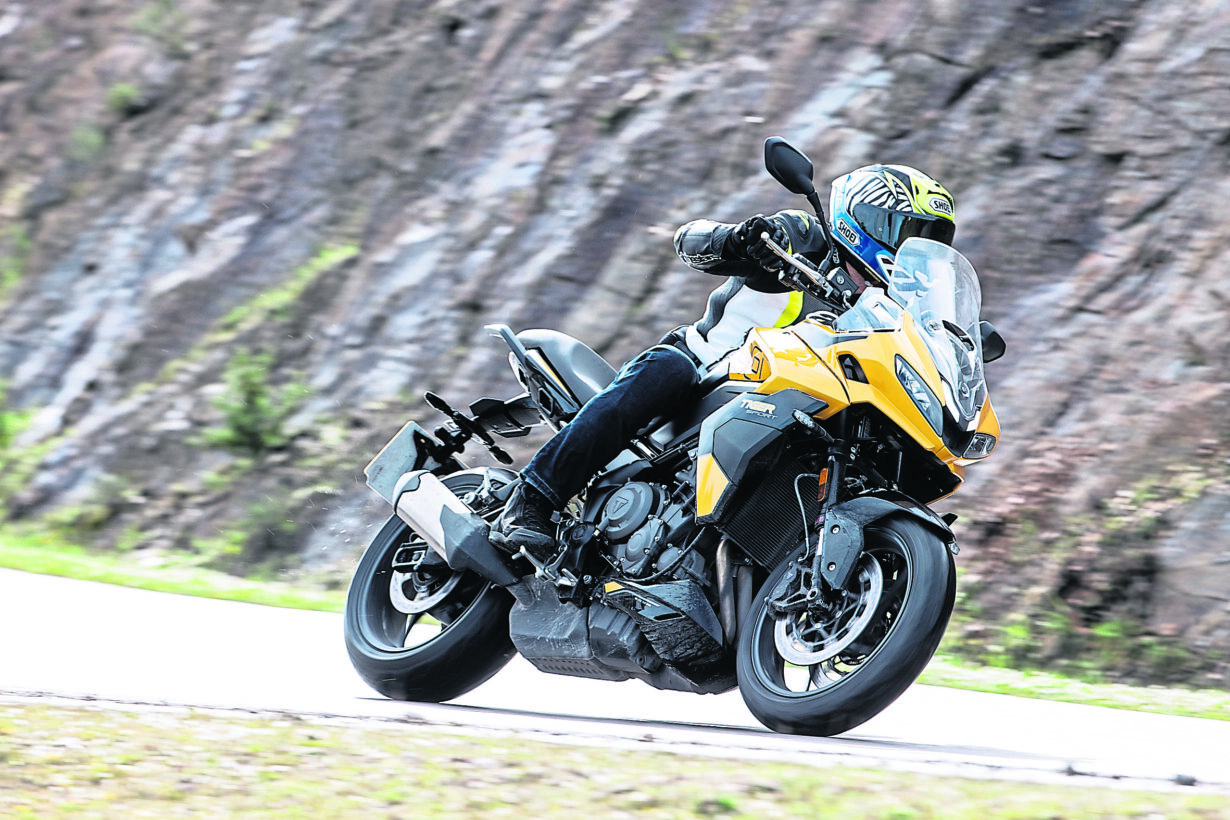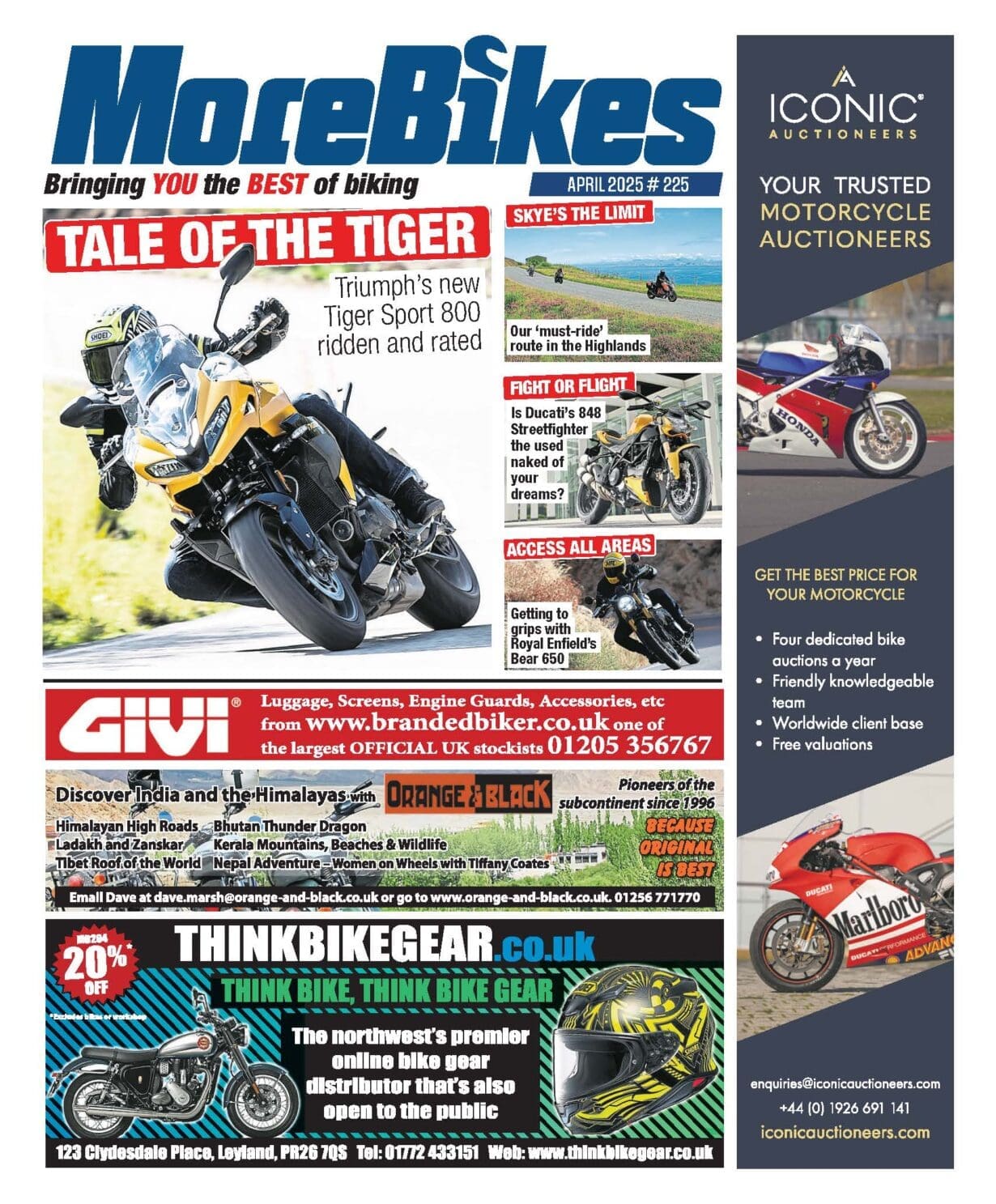If you’re after one bike that can do it all, Triumph’s new Tiger 800 Sport could be just the ticket! Editor Bruce Wilson reports…
Let’s be honest, we all want the world on a platter these days but unless you’re lucky enough to have the cash for two wholly different styles of bikes, the likes of Triumph’s new Tiger 800 Sport could be the tonic to such a quandary.
Based largely around the thinking of its smaller capacity, but big-selling Tiger Sport 660, the new 800 is in place to bring more power, more sophistication and more capability to the market. Priced at roughly £11k, it’s not cheap, but nor is it lacking in performance or features, with perhaps the biggest talking point being the new motor.
Technically speaking, it shares certain components with several different triple engines from Triumph’s line-up, but this engine is so far unique to this bike. Despite what you might think, it’s not just a bigger bore or longer stroke Tiger Sport 660 motor, because that wouldn’t have allowed the brand to achieve the performance and compactness that it was hoping for. Similarly, they resisted the simple solution of just bolting in an engine from the Street Triple or Tiger 900 because neither of those had the right character for the build. It goes to reason that Triumph had a solid idea of exactly what they were hoping to achieve, and they’re pretty confident that’s exactly what they’ve ended up with.

Another thing that sets this apart from the 660 is the use of three separate throttle bodies instead of one, that dictated a slight altering of the otherwise unchanged frame to accommodate them. Why did they bother? Well, it was all part of the process to help achieve better fuelling and a crisper delivery, alongside a new full-length exhaust system which has played its part in putting a claimed 113bhp output on the cards, alongside a healthy side order of 84Nm of torque.
Of course, for a bike designed to carry a pillion, plus luggage and as much duty free as you can smuggle through customs, a bit of poke for such a machine is a prerequisite, especially when you factor in the kerb weight for the Tiger is a hefty 214 of your finest kilos. It is certainly no featherweight, but it’s built to do a job and arguably what the tubular steel frame adds in mass, it offers much more in strength and useability. Besides, tubular frames are pretty cool, right? They might not be everyone’s cup of tea these days, but the utilitarian guise they offer only adds to the Tiger’s presence.
Seeing this bike in the flesh on its launch in Portugal, it certainly looked the part of a do-it-all globetrotter, with high handlebars, a tall and adjustable screen, and a stepped saddle so big you could fit the whole neighbourhood on it. Well, maybe not quite, but you get the point – it’s a big ’un. And it felt immediately comfy, too, when I clambered aboard and realised that the ergonomics on this thing were well suited to my ageing bones. The Triumph’s a very spacious and accommodating machine, nicely packaged with a solid degree of design and detail to take in.

Technologically speaking, the bike’s got all the trinkets you’d expect from a modern-day mile-muncher, including cruise control, cornering traction control and cornering ABS, plus a shifter and blipper as standard – though heated grips will cost you extra.
What very much does come as part of the package is the polarising dash. Let’s be honest, it stands out but maybe not for the right reasons, especially when compared with some of the fancier examples to be found on contemporary models. During the bike’s presentation, it was a hotbed for criticism, with Triumph’s response being that they built this bike with what it needs first and foremost, in a bid to keep the pricing respectable.
Looks aside, it’s packed with features such as three different rider modes that alter the throttle characteristics, traction levels and power figures accordingly. As you’d expect, it’s got full connectivity, too, so from smartphones to Bluetooth intercoms, there are no qualms as far as interaction goes.
While the dash might be questionable, the choice of suspension isn’t, with good-quality Showa 41mm forks up front and a fully adjustable Showa shock at the back, with a remote preload adjuster to make life easier. If you want one with panniers, you’ll have to dig a little deeper in your pockets – roughly to the tune of a grand – as they don’t come as standard, but the rear subframe is designed to integrate them seamlessly, featuring a quick mount and detachment system.
Truthfully speaking, they were the last thing on my mind when the time eventually came to ride the Tiger and the heavy rain began to fall. Cranking my heated grips to the max and lifting the screen to its highest placing, I was surprisingly dry and toasty during the first 30 miles we undertook, dodging the many fallen branches, rocks and rivers of water that made the Algarve’s relentlessly twisting switchbacks even more challenging.

Still, having your hand forced to the worst of the weather can often tell you so much more about a bike, such as how smooth and predictable the triple’s output was in rain mode, while the stability and agility of the bike made life easier when asking it to move last minute to avoid unsighted debris. My initial thoughts were very positive, but how would it cope on drier roads at a faster pace? Well, we were still hours away from such delights, but at least it’d stopped lashing it down after a quick sip of coffee and too much cake at the day’s first stop.
Back on the road, the pace definitely quickened, and the character of the Triumph started to shine through. While the roads were still slick, I’d had enough of Rain mode so switched the bike effortlessly to Road mode, which allowed for a sharper throttle and less traction intervention. While the dash might not have been the fanciest, navigating it was simple enough, aided by easy-to-use switchgears. With the engine more free, the triple’s delivery felt so much more alive, made all the sweeter by its crisp delivery and predictably linear spread of power. There were no peaks or troughs to note as I hooked gear after gear, using the blipper and shifter. While I’d stop short of calling the gear-changing gismos the slickest on the market, the Tiger would’ve definitely been a lesser bike without them. Perhaps my bike was just so new that the gears were still bedding in, but on a few occasions I felt switching through the selections, be it up or down, could have been cleaner and sharper.
The other thing I should probably note at this point was the inconsistency of the traction control. To be clear, I was taking a few liberties, and it seemed like the rear tyre had a fight on its hands trying to cling to the Tarmac, so the dash’s orange TC light was lit up almost constantly. By and large, it made little impact to the ride, being very much present but not disrupting anything, but on a few occasions, the cut of drive was quite harsh and unsettling. I guess the alternative could have been a highside so I don’t want to be too harsh on the system, but that’s just what I found.
Likewise, the non-switchable ABS never seemed too far away from engagement in these sketchy conditions. A big change for the 800 is a switch to four-pot radial calipers, as opposed to the 660’s twin-pot slide jobbies, and on the whole I was impressed by their bite and feel.
We’d been riding for at least four hours before hints of dry roads started to appear. To the likes of myself and a few others, this was akin to a red rag to a bull. Sport mode joined the party and so did some much more spirited riding. While the morning’s ride had been at a fair pace, it was only now that I was able to really appreciate the way this bike handled. The wide bars and short wheelbase undoubtedly helped when it came to throwing the bike around, as it seemed to glide easily wherever I placed it and stayed stuck to the ground, thanks to the planted disposition of the Showa suspension. It was an easy bike to gain confidence on, being very telling of what was going on underneath it at all times. The Michelin Road 6 tyres had been great in the wet and were now proving that they, too, could hack it when being pushed a lot harder.

There was one photoshoot we undertook on nearly dry corners, consisting of a couple of big, fast sweepers, and that’s another place where the Tiger showed its hand. Pitching into the bends, at high speed, it felt stable and obliging, but when asking for that final bit of lean, the long travel suspension seemed to work against the bike. It never caused me any real issues, but I was mindful of the fact that I was overplaying my hand and being warned to rein things in a bit.
I actually liked the way the bike delivered that warning, not in an aggressive manner, but in a way that couldn’t be misinterpreted. It goes to reason that for a machine with such long legs (150mm of travel at each end), and a good chunk of weight, too, there’ll always be a point in time at which physics simply work against you and on those bends, I found that.
Everywhere else we’d ridden that day, the suppleness of the Triumph had proven a good thing, hoovering up road imperfections a treat and making the ride nothing short of pleasant. In fact, that’s the best way of summing up the whole day’s ride. Throughout the course of it we’d had a massively varied and rounded riding experience, on all types of roads at all kinds of pace, but the Tiger seemed to take it all in its stride, keeping my body comfy throughout, thanks to its considered ergonomics.
I liked the engine, I liked the handling, and I very much liked the relaxed riding position that made big miles so effortless. Hell, I even loved the sound of the thing, that only seemed to get better with revs. Having ridden and enjoyed the Tiger Sport 660 in the past, it’s fair to say I had high hopes for the 800… and it didn’t disappoint.
Is it the best sub-litre sports-tourer on the market? That’s one for you to decide, but what I will say is that for those that are after a genuine all-rounder with striking looks and an even harder hitting soundtrack, I don’t think you’ll be disappointed with what this Triumph’s got to offer.
Specs: Triumph Tiger Sport 800
Engine
Type: 798cc, triple cylinder, liquid-cooled
Bore x Stroke: 78mm x 55.7mm
Compression: 13.2:1
Fuelling: EFI
Claimed Power: 113bhp @ 10,750rpm
Claimed Torque: 84Nm @ 8500rpm
Chassis
Frame: Tubular steel perimeter
F Suspension: Fully adjustable, 41mm Showa forks
R suspension: Showa RSU monoshock with full adjustability
Front brakes: Four-piston monobloc calipers and 310mm discs
Rear brake: Single-piston caliper, 255mm disc
Electronics
Riding Modes: Yes
Traction Control: Yes
ABS: Yes
Quickshifter/Autoblipper: Yes
Wheelie Control: Yes
Launch Control: No
Dimensions
Wheelbase: 1422mm
Seat Height: 835mm
Wet Weight: 214kg
Fuel Capacity: 18.6 litres
Info:
Price: £10,995 From: www.triumphmotorcycles.co.uk


